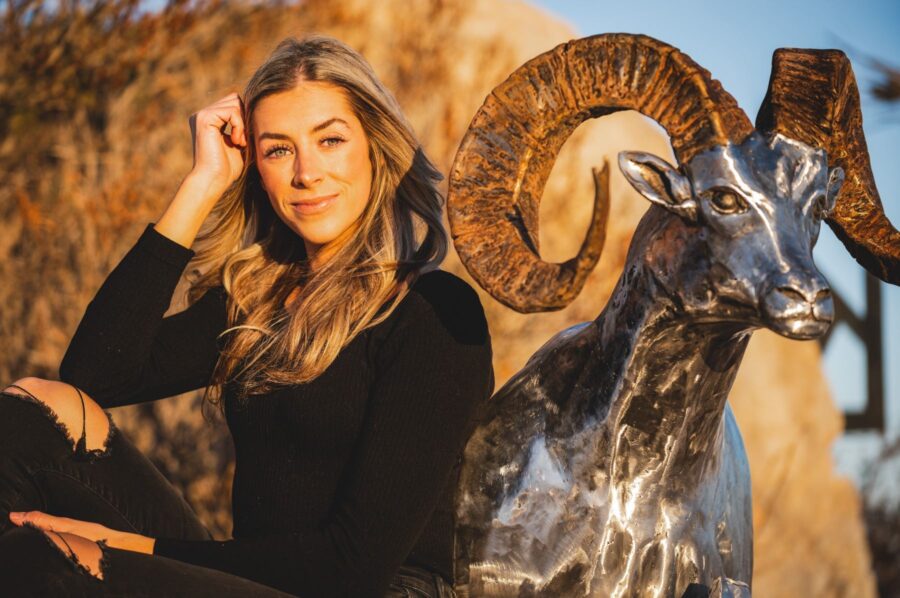Where Steel Meets Soul
Metalworking and sculpture are two crafts almost as old as human civilization. The enduring power of transforming materials, particularly metal, continues to captivate the senses both in the craft and the finished product. It is within this crucible of raw material and refined skill that artists like Jen Phillips, widely recognized on social media as Jen Loree, are forging new narratives. Her work transcends mere labor, elevating the industrial process of welding into a vibrant, deeply expressive form of contemporary art. Loree’s emergence as a significant voice highlights a crucial cultural shift: the growing appreciation for artists who seamlessly bridge traditional trades with fine art, especially those who draw direct inspiration from the natural world.
Her unique journey, deeply rooted in the rugged landscapes of Alberta and a journeyman welder’s grit, offers a compelling counter-narrative to conventional art world narratives. From crafting a simple blue jay from repurposed cutlery for her grandfather to creating intricate, high-end wildlife sculptures, Loree’s story is one of unexpected artistic ignition. Her personal spark, which quickly gained viral traction through platforms like Ducks Unlimited and outdoor writer Jim Shockey, underscores the potent intersection of authentic passion, technical mastery, and digital reach in today’s dynamic art ecosystem.
Jen Loree’s path, defined by her evolution from a “journeyman welder turned metal artist” , directly challenges the historical distinctions often drawn between skilled trades and fine art. Her background, which includes earning a rigorous B-pressure pipe welding certification , provides her with an intimate, practical understanding of metal that many conventionally trained artists may lack. This deep technical proficiency allows for a level of detail and realism in her sculptures that is truly remarkable. Her success, particularly as a woman excelling in traditionally male-dominated trades and then transitioning into a recognized artist, exemplifies a broader societal movement. This shift involves valuing diverse pathways into the arts and expanding the very definition of contemporary art to embrace the inherent artistry in craftsmanship and the vital role of tangible, material-based practices in a world increasingly dominated by digital experiences.

The Legacy of Metal Artistry
Metal has served as a foundational medium in art for millennia, its history deeply intertwined with human civilization and technological advancement. Its artistic journey traces back to the Bronze Age, around 3000 BCE, when ancient civilizations across Mesopotamia, Egypt, and Greece pioneered intricate metalwork. These early artists crafted statues, jewelry, and ceremonial objects from bronze, demonstrating a sophisticated mastery of the material. A prominent early example, the Statue of Amun from ancient Egypt, dating to approximately 1300 BCE, stands as a testament to the advanced artistry of these early metalworkers. As societies evolved, so did the techniques and applications of metal, with examples ranging from the intricate filigree of the Byzantine Empire to the elaborate armor of medieval Europe and the integration of metal elements into the masterpieces of Renaissance artists such as Leonardo da Vinci and Michelangelo.
The genesis of welding, initially a rudimentary process of hammering heated metals together, also dates back to ancient times. Records indicate that ancient Egyptians employed charcoal for pressure-welding swords as early as 3000 B.C. The Middle Ages witnessed the flourishing of blacksmithing, where forge welding became central to creating a vast array of objects, from weaponry to essential household items. However, the true revolution in welding arrived with the Industrial Revolution, which spurred significant scientific breakthroughs. Sir Humphry Davy’s discovery of the electric arc in 1800, followed by Vasily Petrov’s creation of a stable electric arc in 1802, and Edmund Davy’s discovery of acetylene in 1836, collectively laid the groundwork for modern gas and arc welding techniques. These methods became practical in the mid-19th century. World War I dramatically accelerated the adoption and refinement of welding, particularly in the rapid construction of ships and airplanes, paving the way for further innovations such as automatic welding in the 1920s and the development of carbon and metal electrode arc welding.
The evolution of welding from a purely utilitarian process to a sophisticated artistic tool mirrors the broader trajectory of metal art itself. While its industrial utility expanded, metal’s artistic potential steadily grew. From the elaborate armor of medieval Europe to the Renaissance masters incorporating metal into their works, the medium’s versatility was consistently recognized. In the 20th century, artists like David Smith and Anthony Caro revolutionized metal sculpture, pushing formal boundaries with abstract forms and the innovative use of industrial materials.
More recently, contemporary sculptors such as Walenty Pytel have continued to demonstrate metal’s remarkable capacity for capturing lifelike detail and movement, particularly in his realistic animal sculptures crafted from steel and copper. This historical continuum underscores how advancements in metalworking techniques have consistently provided artists with new means to express their visions, transforming raw material and industrial processes into powerful artistic statements. This historical progression highlights a continuous dialogue between industry and art; industrial innovation, often driven by practical needs, creates new tools and materials, which artists then appropriate and recontextualize, pushing their aesthetic and conceptual boundaries.

Jen Loree’s Contemporary Forge, Crafting the Wild
Jen Loree’s artistic journey is a compelling narrative of resilience, determination, and creative reinvention. Beginning her path as a journeyman welder, she honed her skills in the demanding environment of pipeline construction in Alberta. Her dedication was evident in her achievement of a rigorous B-pressure pipe welding certification shortly after giving birth, showcasing her unwavering commitment to her trade. When the industrial landscape shifted and oil field work slowed, Loree pivoted, initially establishing Metal Monkey Design Co. to produce practical metal items like table bases. The pivotal moment that ignited her artistic career was a heartfelt gift: a small blue jay meticulously crafted from repurposed cutlery for her grandfather, which she describes as “sparking her passion”.
This seemingly simple act quickly gained organic momentum, leading to requests from family for other animal pieces, such as a dragonfly and a mallard fashioned from spoons and knives. The unexpected virality of her mallard sculpture, shared by prominent organizations like Ducks Unlimited and acclaimed outdoor writer Jim Shockey, rapidly transformed her “cute little hobby” into a recognized artistic endeavor, propelling her to field requests from across North America. Loree has since created art for notable figures like Disney and Joe Rogan.
Loree’s signature artistic style is characterized by her creation of high-end, remarkably realistic wildlife sculptures. Her growing portfolio includes intricate pieces such as custom steel moose antler mounts , detailed dall sheep art, and other animal forms that capture the essence of their wild counterparts. Her thematic inspiration is deeply rooted in her personal connection to the outdoors, reflecting her upbringing in rural Alberta, where hunting, fishing, and exploring the wilderness were integral to her life. Her popular YouTube channel, “The Forge Chronicles,” serves as a dynamic platform where she documents her process of creating “epic metal sculptures,” connecting with clients in “cool places,” and engaging in “badass outdoor adventures”. This consistent thematic thread of wildlife and adventure resonates profoundly with a dedicated community that values both the natural world and the exceptional craftsmanship required to immortalize its spirit in metal.
Operating primarily from her single-car garage studio, Loree’s artistic process is a testament to both her technical mastery and her deep understanding of metal. While specific welding techniques like MIG or TIG are not exhaustively detailed in the provided information, a YouTube transcript offers valuable insight into her foundational approach. She emphasizes the importance of “elbow grease and time” and recounts starting with basic tools, “a welder, an angle grinder and and a freaking carpenters’s hammer”. This suggests a hands-on, labor-intensive method where physical manipulation and perseverance are paramount.
She also mentions using “pulse” welding to minimize spatter, indicating a nuanced understanding of how to achieve cleaner, more refined results, which is crucial for the intricate details of her realistic sculptures. Her ability to translate the organic forms and textures of living creatures into rigid metal, often using repurposed materials, speaks to an exceptional command of material manipulation and an acute eye for detail, a quality she explicitly highlights as essential for a “good artist”.
Loree’s market strategy is notable for its departure from traditional gallery representation, instead leveraging a robust direct-to-consumer model amplified by her strong digital presence. She maintains active profiles across major social media platforms including YouTube, TikTok, Instagram, and X , where she cultivates a direct relationship with her audience. Her Metal Monkey Design Co. website, while featuring a “Legacy Gallery” and “Original Artwork” section, does not explicitly list traditional exhibitions or gallery representation. Instead, her “Original Artwork” often directs potential buyers to eBay.ca for bidding, indicating a primary reliance on online auctions for unique pieces.
This innovative approach has enabled her to build a substantial following (e.g., 14K YouTube subscribers ) and connect directly with a passionate clientele, particularly within the hunting and outdoor communities. Her features on “The Josh Smith Show” podcast, where her sculptures are described as “redefining the hunting world,” underscore her significant impact within this niche market. The overwhelmingly positive comments on her social media, with fans praising her “awesome work” and “badass” creations, further attest to her popular appeal and the effectiveness of her direct engagement strategy.
The success of Jen Loree, achieved largely outside traditional gallery and museum circuits, highlights a significant trend in the contemporary art market. Her robust direct-to-consumer model and substantial social media following demonstrate that popular engagement and commercial viability can serve as powerful forms of validation, even without the imprimatur of established art institutions. This approach allows her to control her narrative, pricing, and distribution, reaching a global client base directly. Her particular success within the hunting and outdoor communities further illustrates how niche markets can be effectively cultivated through a targeted online presence. This trend suggests a future where artists’ entrepreneurial acumen and digital literacy are as crucial to their career as their artistic talent, potentially reshaping the traditional art market structure and fostering new, more direct patronage models.

Beyond the Weld, Critical Dialogues in Metal Sculpture
Jen Loree’s work inherently engages with the enduring “art vs. craft” debate, a discourse that has long shaped the perceived value and categorization of creative endeavors. Historically, “craft” mediums like metal, ceramics, fiber, glass, and wood were often relegated to a secondary status, associated with functionality and utilitarianism, thus deemed “lesser” than “fine art” (e.g., painting, traditional marble sculpture) which emphasized pure self-expression. However, the mid-20th century’s studio craft movement began to challenge this hierarchy, encouraging personal expression within craft disciplines. Contemporary critics like Claire Benn argue that the distinction is not hierarchical, but rather lies in the
intent and impact of the work. If a piece, regardless of medium, possesses “expressive, engaging, communicative, and transformative power,” it transcends simple categorization. Loree, a journeyman welder, clearly brings a deep mastery of her material and technique. Her intricate, realistic wildlife sculptures, while demonstrating immense craftsmanship, also evoke emotional responses and tell stories of nature and adventure, positioning them firmly within the realm of fine art by Benn’s definition. Her success in creating pieces for high-profile clients like Disney and Joe Rogan further blurs these lines, indicating market recognition beyond traditional craft circles.
Realistic wildlife sculpture, a genre Loree excels in, faces its own set of critical considerations within contemporary art. While some abstract or conceptual art might be favored in certain institutional contexts, realistic animal forms often resonate deeply with a broader public. Artists like Walenty Pytel, known for his lifelike animal sculptures using steel and copper, demonstrate the continued relevance and appeal of this approach. Moreover, contemporary wildlife art is increasingly being recognized for its social and environmental significance. Public sculptures, such as Gillie and Marc’s “Wildlife on the Edge” series, strategically placed in urban environments, serve as powerful vehicles for raising awareness about endangered species, habitat loss, and the urgent need for conservation. These works challenge the notion that wildlife is confined to distant wildernesses, integrating it into daily urban life and fostering a deeper connection and appreciation for nature. This “artivism” highlights how realistic representation can be a potent tool for didactic purposes and social commentary, moving beyond mere aesthetic appreciation to provoke thought and action.
Loree’s primary engagement with her audience through direct online sales and social media, rather than traditional galleries, presents a nuanced case study for institutional reception. While she may not be exhibiting in major museums (no evidence of this in the provided information ), her significant commercial success and popular appeal, particularly within the outdoor community, demonstrate a robust alternative market. This raises questions about how the art world defines “success” and “relevance” in an era where direct artist-to-consumer models are increasingly viable. The market for wildlife art, generally, is a popular genre with a dedicated collector base, ranging from private collectors to interior designers, and can achieve significant auction results, as seen with artists like David Shepherd.
Loree’s approach taps into this existing demand while cultivating a unique brand identity rooted in her personal story and connection to adventure. Her success, achieved largely outside traditional gallery and museum circuits, challenges the conventional metrics of artistic validation. Her strong direct-to-consumer model and significant social media following suggest that popular engagement and commercial viability can be powerful forms of validation, even without the imprimatur of established art institutions. This phenomenon forces a re-evaluation of what constitutes “art world success” and how artistic value is accrued and disseminated in the digital age, implying that the gatekeepers of the art world are losing some of their singular authority, and alternative pathways to artistic prominence are emerging.

The Horizon of Metal, Future Trajectories
The field of metal sculpture continues to evolve, driven by both technological advancements and a renewed focus on materiality and environmental themes. Contemporary metal artists are increasingly exploring innovative techniques, from advanced robotic fabrication to intricate laser cutting, alongside traditional methods like forging and casting. There is a growing interest in sustainable practices, including the use of recycled or repurposed metals, which aligns with Loree’s initial use of cutlery for her early works. Furthermore, the integration of digital design tools, such as 3D modeling, can enable artists to create complex forms that are then translated into metal, pushing the boundaries of what is physically achievable.
Given Loree’s foundation in both practical welding and artistic expression, her future trajectory could see several developments. Having mastered realistic forms, she might explore larger-scale public installations, similar to how other metal artists contribute to the cultural landscape through public works. This could allow her to engage with broader environmental themes, moving beyond individual wildlife portraits to create immersive natural environments in metal. While her current work is highly realistic, she could delve deeper into the critical discourse surrounding human-animal relationships and conservation, perhaps incorporating more abstract or symbolic elements that evoke the fragility or power of nature, akin to artists who use animal forms for social commentary.
Her connection to “adventure” could evolve into more narrative or interactive pieces that invite viewers to reflect on their own relationship with the wild. Her journey as a “woman in trades” and an artist could also lead to collaborations with other artists, designers, or even conservation organizations. Her social media presence already inspires aspiring welders and artists , suggesting a natural progression into mentorship or educational roles, potentially through workshops or online courses that share her unique blend of technical skill and artistic vision.
The digital platforms that have been instrumental to Loree’s current success will undoubtedly continue to shape her artistic and commercial future. Live-streaming her creative process, offering virtual studio tours, or even experimenting with augmented reality (AR) to showcase her sculptures in various environments could further enhance engagement. The direct-to-consumer model, which she already utilizes, is likely to become even more sophisticated, potentially involving NFTs for unique digital representations of her physical works, or crowdfunding for ambitious large-scale projects.
This continued digital presence will be key to maintaining her global reach and fostering a loyal community around her “Forge Chronicles” brand. Loree’s active social media presence, characterized by high engagement and direct interaction with her audience, is not merely a marketing channel but likely a significant influence on her artistic evolution. The immediate feedback from her community, including questions about techniques or suggestions for subjects, can directly inform future projects and the content she chooses to highlight. This continuous dialogue fosters a responsive and evolving artistic practice, demonstrating how digital platforms are becoming integral parts of artists’ creative ecosystems, enabling iterative development and direct community building that shapes artistic output and commercial strategy.

The Enduring Spark
Jen Loree’s journey from the industrial forge to the realm of fine art epitomizes the transformative power of dedication and vision in contemporary sculpture. Her ability to breathe life into rigid metal, crafting realistic wildlife forms, stands as a testament to the enduring allure of material mastery and authentic expression. Loree’s career highlights several crucial aspects of today’s art world: the blurring lines between traditional craft and fine art, the potent role of social media in democratizing art markets and fostering direct artist-audience relationships, and the growing appreciation for art that connects deeply with themes of nature and adventure.
Her work also serves as an inspiration for women in trades, demonstrating that skill and passion know no gender boundaries. As the art world continues its dynamic evolution, artists like Jen Loree, who seamlessly blend technical prowess with a compelling personal narrative and a keen understanding of digital engagement, will undoubtedly continue to shape its future, proving that the most profound artistic statements can often emerge from the most unexpected of places. Her work leaves us contemplating not just the beauty of the weld, but the boundless adventure of artistic possibility.









